Menu
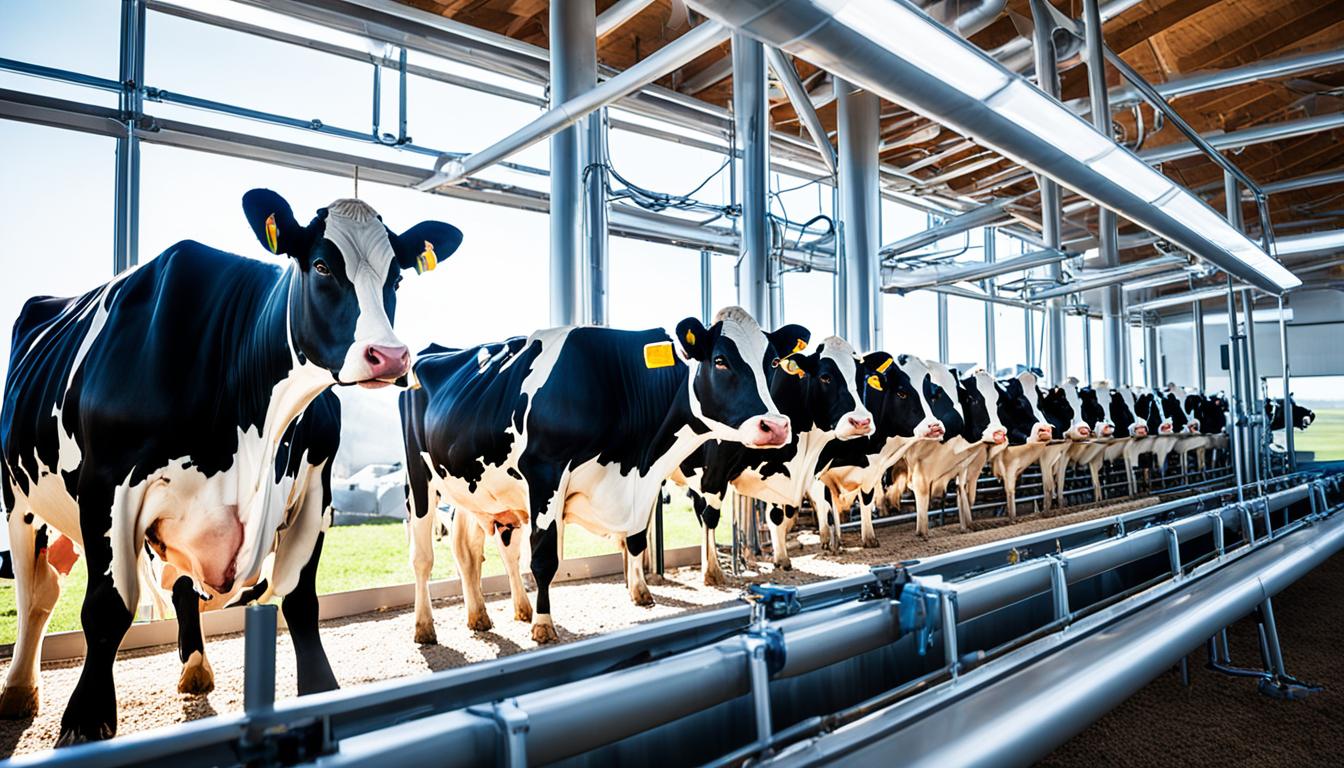
Did you know that using advanced tools in dairy farms can lower planned downtime a lot? This boosts the efficiency of the whole farm. The use of smart technology in dairy farming has led to big changes. Farmers now make choices based on data, which helps increase how much they produce.
By using advanced tools, farmers not only keep up with the latest technology but also see huge improvements. When they use things like digital signals and milking machines that work on their own, they get better milk, healthier cows, and their farms run smoother. The new technology also means they have better control over each stage of making dairy products. This control gives them an advantage over others in the dairy business.
Over in Pennsylvania, about 35 dairy farms are using Automatic Milking Systems (AMS). This shows that many farms are choosing to use these new and successful technologies. The robotic milking systems work all day, every day. This has led to cows being healthier and producing more milk. It’s helped set higher standards for what we expect from the dairy industry.
Robotic dairy systems, known as automatic milking machines, have changed dairy farming today. They do the milking without humans, which means cows can move freely and are less stressed. This new technology shows a step towards better ways to look after dairy herds.
Robotic dairy systems really do change how we milk cows on farms. They use robots and sensors to milk cows effectively and with less human work. This method improves how we look after cows, their health, and how much milk they make.
It focuses on caring for each cow rather than all cows together, which is traditional. This way, cows get the exact care they need and produce more milk.
People wanted to make dairy farming more efficient and better for cows, so they invented these systems. Before, milking cows was labour-heavy and stressed the animals. Then, in the late 20th century, the first automatic systems were made.
These have evolved into today’s advanced systems. They not only milk cows but also track their health and productivity closely.
Moving from old milking methods to new robots is a big change for farms. They start with 50-60 cows per robot and gradually introduce them. This way, cows get used to the new system without stress.
Planning the barn layout right and letting cows move freely are key. They help produce more milk and use feed better.
It’s also important to think about how cows get used to visiting the robots. Giving cows lots of chances to visit the robots keeps them healthy. Being gentle and calm with cows when they first meet the robots is vital. It helps cows see the robots as friends, not something to be scared of.
“Free cow traffic is a pivotal component in successful robotic milking, leading to benefits like increased milk production per cow, reduced lameness, and improved feed efficiency.”
In short, robotic dairy systems help farmers look after cows better. They take us from old, hard ways of milking cows to new, easier methods. This change is good for cows, milk production, and farm work in general.
Dairy farms are changing with new technology. Robotic milking systems (RMS) are now in use all over. This change is making dairy farming better and more efficient. The key benefit is more milk, thanks to cows being milked more often by the robots.
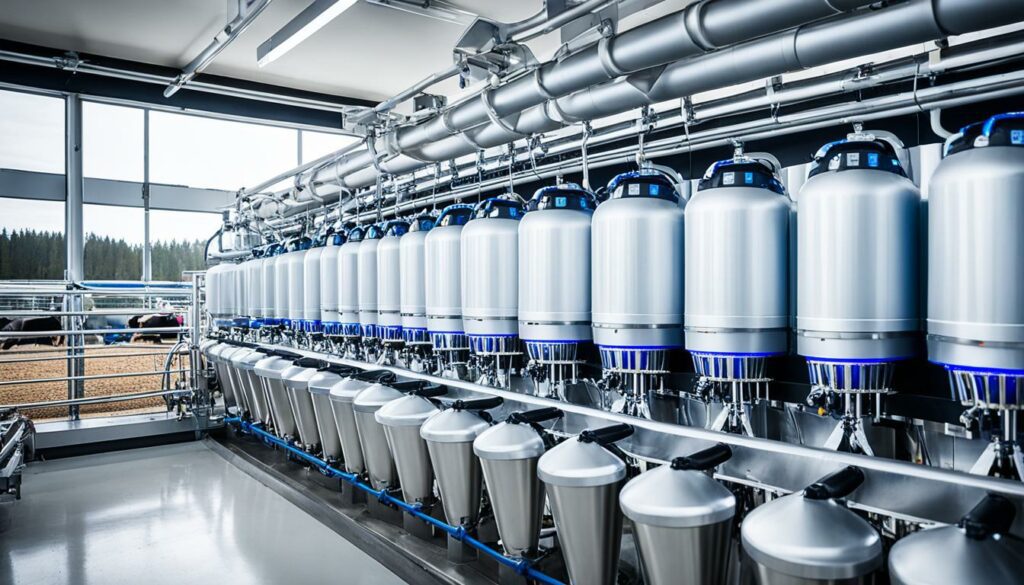
Cows are usually milked twice a day. But, robots allow more milkings, about 2.6 times each day. This matches their natural needs better, making cows less stressed and healthier. Robotic herds make 5 to 10% more milk than usual ones, showing how well these systems work.
Milking more often means more milk. Some US farms get over 6,000 lb of milk from each robot daily. If a farm has 180 cows, using robots is profitable if each cow makes just 2 lb more of milk daily. Small farms that have switched to robots see up to 20% more milk, which greatly helps their business.
| Metrics | Traditional Parlour Systems | Robotic Milking Systems |
|---|---|---|
| Average Milkings per Cow per Day | 2.0 | 2.6 |
| Milk Production Increase (%) | Baseline | 5-10% |
| Average Milk Yield (lb per robot daily) | Not applicable | 6,000 |
| Additional Investment ($) | – | $150,000-$200,000 |
In short, more milkings and more milk is good for farms. Robotic milking helps farms make more milk and keeps cows healthy. It’s a great help for farmers.
Robotic systems have changed how we care for cows on farms. They use the latest tech to watch over each cow’s health and happiness. This means we can help them quickly when they need it.
These systems are great at watching out for cow health. They keep track of things like each cow’s teat health. So, if a cow has mastitis, farmers know fast and can help. This means less sickness in cows and a happier, healthier herd.
Farms using robots are better for cows than old ways of milking. Robots make milking more peaceful and safe. In Michigan, 55 farms with 243 robots are seeing the benefits. They’ve found their cows are less stressed and healthier.
| Metric | Traditional Systems | Robotic Systems |
|---|---|---|
| Employee Reduction | 0% | 20% |
| Increase in Milk Yield | 0-2% | 5-10% |
| Stress Levels | High | Low |
Robotic systems also let cows be more natural. This makes them less stressed. Over time, cows using robots are happier and work better. So, the cows’ lives are better and so is the farm’s productivity.
Robotic dairy systems are changing how we look at labour efficiency and cost savings on dairy farms. By using Automatic Milking Systems (AMS), farmers save time. They can save over 0.06 hours daily per cow, which is a big deal. This means a 38% saving in time per cow and a 43% saving for the same milk amount.
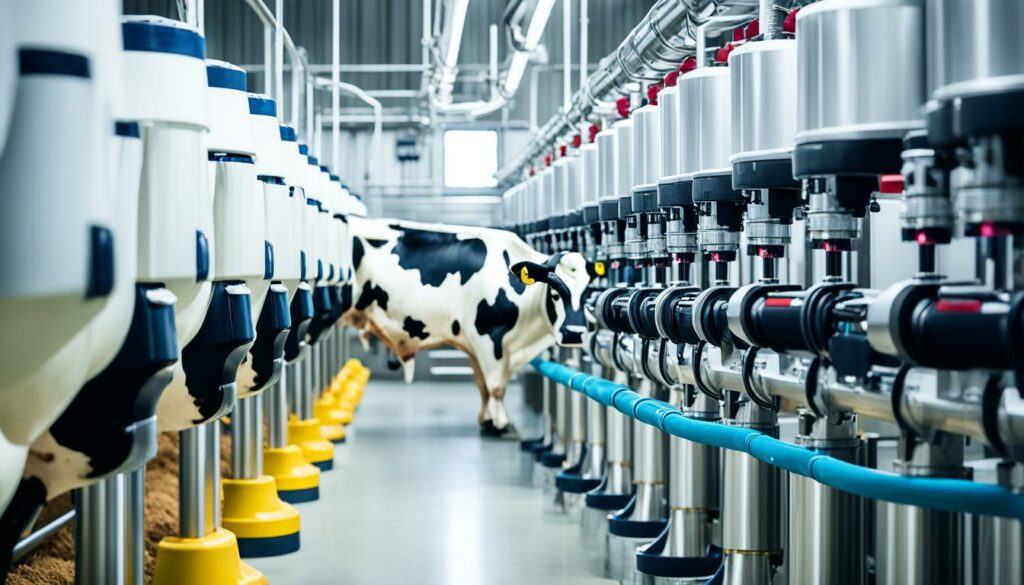
A study found that 25% of farmers saved more than 0.10 hours per cow daily. This equals about $2.4 per hundredweight at a $15 hourly wage. But, 8% didn’t save time due to machine maintenance. Farmers moving from parlour to AMS saved 0.08 hours per hundredweight. Meanwhile, those moving from a pipeline system saved a remarkable 0.16 hours.
Big farms see the best results with AMS. They save more time per cow than smaller ones, showing benefits as farms grow. Using new, not old, buildings for AMS adds another 0.04 hours of savings per hundredweight, worth $0.5 at a $15 wage.
| Parameter | Labour Savings (hours/cwt) | Cost Savings ($/cwt) |
|---|---|---|
| AMS Adoption | 0.10 | $1.50 |
| Parlor System Replacement | 0.08 | $1.20 |
| Pipeline System Replacement | 0.16 | $2.40 |
| New Housing (vs. Retrofitting) | 0.04 | $0.50 |
When farms are already efficient and switch to AMS, they save more time. This shows the power of AMS. Over 2,500 AMS units already work in North America, helping more than 1,000 dairy farms. They milk over 140,000 cows every day.
AMS units really cut down on labour for milking and finding cows in heat. This can save tens of thousands of dollars a year in work costs. Although AMS costs more initially and takes longer to pay for itself, it’s worth it. This is because of the extra milk it helps produce and the better life it offers the cows, making it a smart choice for saving costs on dairy farms.
In today’s precision dairy farming, making decisions based on data is key. Thanks to hi-tech milking systems, farmers can use a large amount of data to boost their farms. This leads to better practices and higher productivity.
AI technology in milking systems handles over 120 data points for each cow. It looks at milk yield, cell counts, and how cows act to spot health issues early. With systems like the DeLaval VMS™, milking is adjusted for each cow, improving milk output. Cows also undergo genomic tests to understand their best traits. This detailed data helps keep cows healthy and productive.
Farmers can better manage their farms with so much data. They use info on milk quality to check for any health problems fast. Also, systems like the DeLaval RePro™ help with finding pregnant cows and those in heat during milking. This leads to less feed waste and better use of nutrients. For instance, the Milk Sustainability Center helps farms cut emissions and use nutrients better.
Data-driven choices are crucial for precision dairy farming. It helps farms work better and protect the environment. Automated systems not only boost farm performance but also help in keeping farming sustainable.
Automated feeding systems have changed the dairy game. They ensure cows get the right nutrition they need. This helps dairy farmers keep a close eye on their herds’ diets.
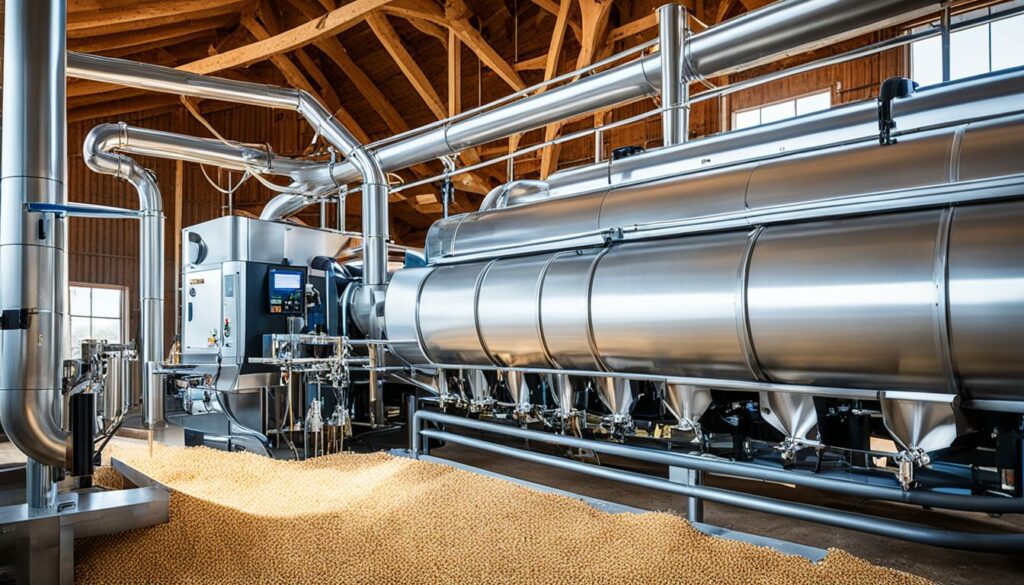
A balanced diet is key for herd health and milk yield. Automated systems are vital for this. They give each cow just the right amount of nutrients, considering their age, health, and milk production.
This approach makes sure cows at their peak get all they need. Meanwhile, it stops less productive cows from getting too much. This boosts both productivity and the cows’ well-being.
A big plus of automated systems is cutting down feed waste. Old ways often meant cows didn’t get or got too much feed, wasting a lot. These systems calculate the exact feed for each cow, saving on costs and reducing waste.
This isn’t just good for money and the planet. It also helps dairy farms meet their sustainability goals. By feeding cows only what they need, we lessen the farm’s impact on nature.
Overall, automated feeding is both efficient and kinder to our planet. It makes sure cows get perfect nutrition, reducing waste and costs. This helps farmers aim higher in sustainability, keeping their cows healthy and their milk top quality.
Integrating advanced health and reproductive monitoring in dairy farms has changed the game. It allows farmers to take better care of their herds and improve productivity. The Lely Astronaut, through its T4C program since December 2009, has been key. This system offers 20 KPIs to carefully keep an eye on how the farm is doing.
Cows are milked over 2.5 times a day on average, sometimes even 2.8 times. This often-milking schedule keeps cows healthy and boosts milk production. The Lely Astronaut stands out because of its special milking mechanism. It reduces mastitis cases by 75% and spots them 90% of the time.
The T4C program can spot beginnings of issues, like watery milk, early. This can catch diseases like E.coli fast. With new software, it can also notice if a cow loses a lot of weight, days before other methods. This early warning system is a game-changer. It makes health efforts more proactive and reliable.
For reproduction, the system does wonders too. It tracks heats, finds if a cow is pregnant, and can predict when they’ll give birth accurately. Farmers can check key reproduction data over time for deep analysis and evaluate farm performance.
The MooMonitor+ is also valuable. It watches how cows move their necks all day and night. This tells farmers if a cow is in heat, eating, resting, or if something’s wrong. Its 24/7 monitoring helps catch fertility issues or sicknesses when they start, boosting the farm’s profits. Most heats happen at night, but the system can pick them up at any time.
The chart below shows some important insights these technologies provide:
| System Feature | Benefit | Impact on Farm |
|---|---|---|
| T4C Early Detection | Watery Milk Indication | Early Disease Intervention |
| Reproductive Module | Heat Registration | Improved Fertility Rates |
| MooMonitor+ | 24×7 Neck Movement Monitoring | Enhanced Cow Health Monitoring |
| Weight Fluctuation Alerts | Early Health Issue Detection | Timely Proactive Interventions |
| Pulsating per Quarter Feature | 75% Drop in Mastitis Cases | Higher Milk Quality |
By using these advanced systems, dairy farmers can boost their herds’ health and productivity. This ensures their farms stay successful in the long run.
Robotic herd management revolutionises the dairy industry by automating animal movements and detecting changes in behaviour. These systems improve how efficiently and safely herds are managed, which is good for the animals.
This technology automates how cows move, thanks to systems like the Lely Astronaut. Cows are motivated to milk up to three times daily. This is better for the cows and boosts milk production.
The Lely Grazeway makes grazing simpler for cows. It lets them choose to graze or be milked inside. Such choices help reduce stress and improve their well-being.
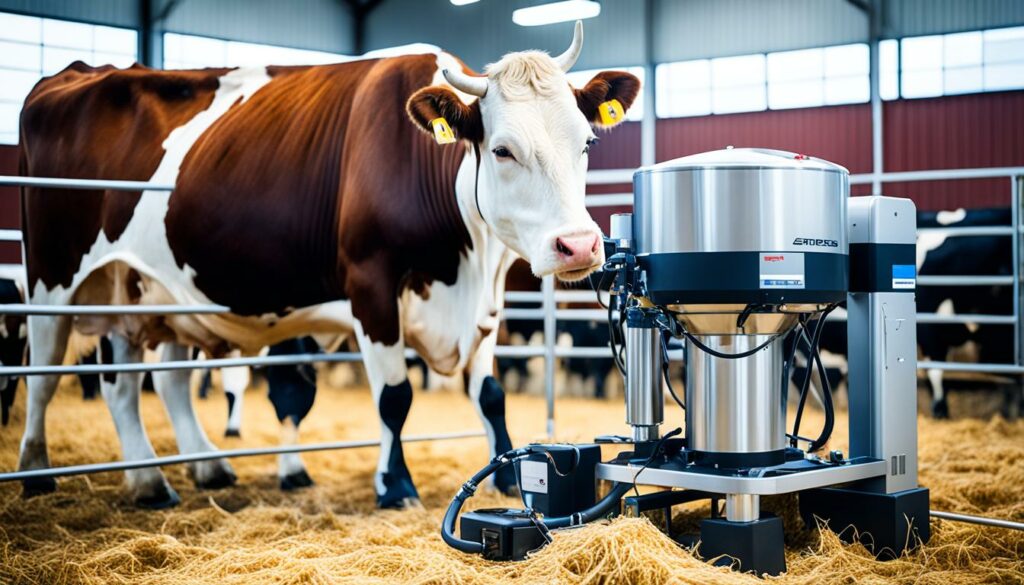
Robotic systems are sharp at spotting changes in cow behaviour, vital for early health issues detection. The Lely Qwes monitors cows every two hours. This allows farmers to catch any signs of sickness quickly.
This proactive approach helps with diseases like mastitis. Early detection means swift treatment, keeping the herd healthy. Monitoring behaviour maintains milk quality and supports herd health.
Many farmers praise this system for how it improves the cows’ life, comfort, and movement. The collected data offers insights for better farm management, focusing on higher cow welfare and productivity.
Dairy automation solutions help tackle the big problem of not having enough workers in the dairy industry. Farms are under pressure to keep up productivity without spending too much on inputs. These hi-tech systems provide a smart way to move forward.
The dairy automation market is now worth USD 1.99 billion. It’s set to grow to USD 3.16 billion by 2030. This growth is mainly because of the need for more automation due to not having enough workers, improving quality, and meeting the global demand for dairy.
Using Automated Milking Systems (AMS) can up the milk yield and make sure the animals are looked after properly. Automated feeding also plays a big part, making the animals healthier and increasing milk production while cutting waste. This saves money in the long run.
Robots with clever sensors keep an eye on the dairy cows’ health and welfare. They make sure the milking areas are very clean, cutting the chance of harmful bacteria spreading.
Robotics really step in at the bottling and packaging stages, making things faster and more accurate. They make sure stocks are well managed and orders are sorted quickly. This saves a lot of manual work.
| Key Benefits | Description |
|---|---|
| Higher Milk Yield | AMS leads to an increase in milk production by mimicking natural rhythms. |
| Improved Animal Health | Advanced systems monitor and enhance animal welfare. |
| Labour Efficiency | Automation reduces the need for physical labour, reallocating workers to skilled roles. |
| Cost Savings | Automation leads to long-term financial benefits by improving efficiency and reducing waste. |
| Hygiene Standards | Automated cleaning systems maintain high standards of cleanliness, preventing contamination. |
Choosing the right automation depends on each dairy farm’s needs, what technology they already have, and their budget. By using these solutions, farms can deal with the lack of workers well. They keep running smoothly, even as the economy and markets change.
Robotic milking systems are now used on dairy farms globally. They bring many benefits but also face some challenges in adoption. Knowing these pros and cons is crucial for farmers who are considering using them.
Robotic milking systems benefits greatly outweigh the drawbacks. With over 35,000 units working worldwide, their success is clear. They can lower labour needs by 30% and need 29% less effort than traditional methods. This helps reduce operational costs significantly.
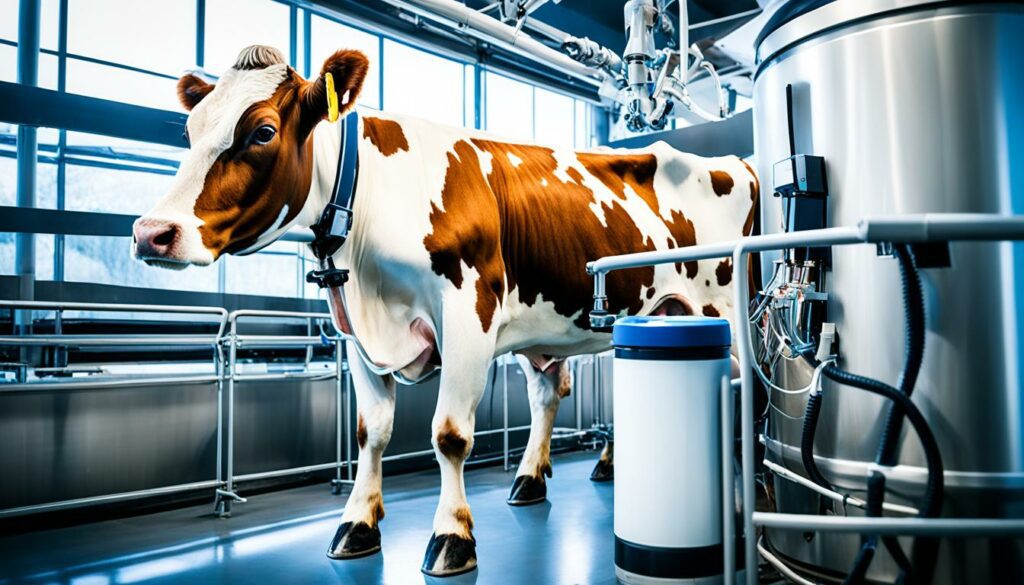
They also boost milk production and earnings. For instance, a study showed that an extra 500 pounds of milk a day from each robot could raise yearly profits by $4,100. This proves that more milk each day means more money.
However, adopting these systems can be tough. The initial cost, between $150,000 and $200,000, is a big barrier for some farms. What’s more, the expenses and upkeep of these robots can sometimes make them less profitable than traditional methods.
The transition for cows and staff takes time too. Farm managers must be skilled to watch over the cows, know the system well, fix any issues, and keep the feeding regular. Even though these systems make work more flexible, total labour doesn’t always go down. So, using these systems effectively takes a lot of work and knowledge.
Before choosing a robotic milking system, a farmer should think carefully. They should weigh the economic benefits against the costs and challenges of installing and using these robots. With the right preparation and understanding, farms can use these systems to their full advantage.
Robotic dairy systems are changing the game in farming. At the front is the Lely Astronaut, a top-notch milking solution. It has boosted the dairy industry with its technology and the competition it inspired in the robotic milking market.
The Lely Astronaut is in a league of its own with its modern milking technology. It’s a favourite worldwide, combining cutting-edge automation, detailed data collection, and cow-friendly setups. Around the globe, 35,000 of these systems are at work, redefining the standard for efficiency.
It costs between $150,000 to $200,000 to install each Lely Astronaut. However, this investment is balanced by a better life for farmers, less work, and the ability to expand operations with no extra labour cost.
Farms in the Netherlands using these systems have seen a 29% drop in labour needs. This makes them more profitable, despite the higher set-up costs. In America’s Upper Midwest, farms with these systems produce more milk per worker than those using older methods.
The Lely Astronaut shines, but so do other robotic milking systems, each with their own advantages. These systems help farms of all sizes run more effectively. The amount of work saved with these systems can be up to 29%, depending on how the farm is set up.
For example, farms in the Upper Midwest using robotic systems make more profit per cow than traditional farms. Even though their overall income per cow is a bit lower. The savings on labour and the extra milk the cows produce really add up over time.
Also, farms with 25 robots can be more profitable than traditional setups, especially if the cows are very productive. As the cost of labour goes up, these systems become even more financially smart for farmers.
Comparing these systems often looks into how well cows move around, efficiency in managing them, and how flexible the farm can be. Setups that let cows move freely, like the Lely Astronaut, offer big benefits. They include more milk, less work, and lower risks of diseases.
In the end, the variety of robotic milking systems gives farmers choices. They can pick what fits their farm the best. This means dairy farming keeps getting better and more innovative.
Robotic cleaning systems are key in dairy farming for top hygiene. They are crucial for producing high-quality milk. These machines clean thoroughly and often, keeping the risk of contamination low, which keeps the milk safe to drink.
Studies show that Lely brush systems are around 40% better at cleaning udders than traditional methods. This level of cleaning means cows are healthier. And healthy cows produce better quality milk.

Ensuring dairy hygiene can be tough but is worth it. Automated milking helps keep udders clean, linked directly to better udder health. If udders are dirty, it can mean more infections and lower milk quality. It’s key to keep udders less than 10% dirty.
Another tip for better hygiene is trimming cows’ tails regularly. Do this every three months in summer and every eight weeks in winter. This helps prevent too much hair around the udder, making milking areas cleaner.
Keeping cow’s feet healthy is also very important. Wet, dirty environments can cause foot diseases. These diseases can lead to cows not wanting to be milked by robots. Cleaning the barn floors often and ensuring good airflow can help prevent these diseases.
It’s also good to soak cows’ feet in a foot bath regularly. This keeps their claws in good shape. Healthy claws mean cows visit the milking robot regularly. All these actions together improve dairy efficiency and look after the cows better.
Robotic milking systems (RMS) boost dairy farm productivity significantly. Over 35,000 RMS units work worldwide. They not only help with milking but also improve milk amounts and make work more efficient. This is key for dairy farm success.
RMS milk cows about 2.8 times each day. This results in more milk from each cow. Farms using RMS in the Upper Midwest produce 2.2 million pounds of milk per worker. This is much more than farms using traditional parlors, producing only 1.5 million pounds. It clearly shows the RMS benefits.
Automated systems also help in saving labour. Reports show a drop in needed workforce by up to 29% with RMS. This means less hard work for people and more focus on skilled jobs. Plus, adding robots to a farm can be a smart financial move. If it increases milk production by just 2 pounds a day, and the robots last over 10 years, it can be more profitable than sticking with traditional methods.
Using these advanced methods makes the dairy sector stronger. It meets market needs and helps the environment. Predictions say the dairy automation market will grow to USD 3.16 billion by 2030. This growth is proof of the importance of automation in dairy farming.
| Metric | RMS Performance | Conventional Parlors |
|---|---|---|
| Average Milking Frequency | 2.8 times/day | 2 times/day |
| Milk per Full-Time Worker (lbs) | 2.2 million | 1.5 million |
| Labour Savings | Up to 29% | N/A |
In brief, using automated dairy systems is a big step forward. It helps farmers do better, spend less, and produce more milk. This is vital for keeping up with global dairy needs.
Robotics have changed dairy farming significantly. There are over 35,000 robotic milking systems (RMS) in use around the world. Even though they need a big investment, about $150,000 to $200,000 each, they can save up to 29% in labour costs. This makes them a good choice for many farmers.
In the Upper Midwest, farms with RMS produce 2.2 million lb more milk per worker than those using older methods. But deciding on RMS isn’t simple. You need to think about how often cows are milked, how much milk they make, and the costs of labour. <!–However, even with more milk from RMS, profits don’t always rise because of the added costs.–>
To make the most of these new systems, farmers should focus on getting the most milk from each robot. This can greatly improve earnings. By using data to make smart choices, farms can overcome challenges and find new opportunities.<!– This step is vital for dairy farms to keep growing and stay innovative.–>
Automated milking machines are called robotic dairy systems. They make milking easier and better for cows. This happens by letting cows move freely and reducing the stress they feel.
Robotic dairy systems started from basic parlours. Now, they are advanced to make cows comfortable and collect precise data for better farming.
Robotic milking lets cows get milked more often, about 3.2 times a day. This increase makes cows give 10-20% more milk than before.
Automatic systems help find and treat cow illnesses early. They also reduce stress for cows. This makes them healthier and more productive.
Robotic systems cut down the work farmhands need to do. This means farms could need 30 to 50% fewer workers. It saves money on labour costs.
These systems use data from robots to make farm decisions. This helps with cow health and deciding what to feed them for the best results.
Automatic feeders ensure every cow eats right. They help keep the herd healthy and make sure there’s less leftover food.
These systems have sensors to check cow health and if they can have babies. They help keep cows healthy and make breeding more successful.
Robotic herd systems control how cows move in the operation. They make things run smoother and safer. They also spot when cows act differently due to health issues.
Dairy automation takes on tasks that used to need a lot of people. This lets farms use workers for more skilled jobs and deal with the cost of more labour.
Robotic milking makes farming more efficient and better for cows. But, it’s a big investment and needs time to adapt. Farm managers must weigh the costs against the benefits.
The Lely Astronaut is top for its automation and care for cows. It’s known for its personalised solutions. It’s a preferred choice for many dairy farmers.
Robotic cleaners keep things clean all the time. They stop dirt from getting into the milk and keep the farm safe. After getting used to them, farmers find them very helpful.
Robots make dairy farms work better in many ways. They help with milking and packing, making everything more efficient. They also make sure cows are well taken care of, supporting farming’s future.